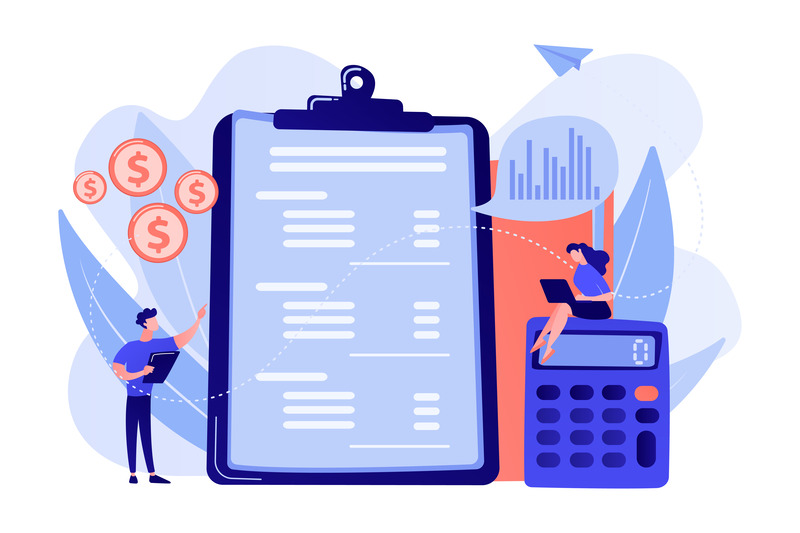Contents

7 Steps to a Simple Budget
You weren’t born to budget. Budgeting is definitely not an innate skill. However, you can learn how to budget. And contrary to popular belief, budgeting is not hard and does not require a degree in finance, in fact, you can learn it now in seven simple steps.
I have struggled with budgeting. I have failed with budgeting. But I have also persevered and achieved the freedom and security that I always wanted in my life through budgeting.
I wrote this article to give you everything I’ve learned.
Budgeting Check-In
Before starting on the seven steps to a simple budget, let’s do a mindset check-in.
Let’s approach budgeting from a different standpoint: Budgeting isn’t restricting, budgeting is freeing. You free yourself from that feeling of fear, worry, and responsibility of not knowing where the heck all your money goes.
There is peace in that. There is peace in knowing exactly where your money went and where it will go.
A Budget Gives You:
- Confidence – you can take care of yourself and provide for your family
- Peace of mind – you stop feeling anxious and stressed about money
- Security – you know your expenses are covered
- Power – the power to decide what you spend your money on and the power to plan for the future.
A budget in its simplest terms tracks what you earn and what you spend.
Item 1 (what you earn) needs to be greater than Item 2 (what you spend).
A budget is for a set amount of time – 2 weeks, a month, a quarter, or a year. Budgets can be chicken scratching on a piece of paper or a spreadsheet on your computer.
Remember, a budget shouldn’t be overwhelming or intimidating. Don’t get me wrong, they can be complicated and detailed, but that’s why I’m here, to simplify this journey for you.
7 Steps to a Simple Budget:
1. Acknowledge that Budgeting is an Ongoing Process (like laundry).
Your budget will grow and shift. Let’s look at Tess. Tess evaluated her previous month’s spending and realized how much she was spending: $400 on entertainment (takeaway, drinks, dinner out, social events, movies, etc.).
For this month, she decided to cut her entertainment expenses in half to $200/month. Simple enough right? Well not necessarily.
The following month she became discouraged because she blew through her entertainment budget without realizing it and found herself “looking” for money at the end of the month. Why? How did this happen? Tess had budgeted. She had set an amount to spend on entertainment. However, she had forgotten one key step – tracking.
Budgeting without tracking expenses is like following a nutritional plan without counting your macros.
Budgeting is not a one-time event. Like laundry, it is always present and needs your regular attention.
Enter into budgeting with the intention of it being an ongoing process that will require your attention on a regular basis. I recommend scheduling a weekly or monthly time to review your budget.
Keeping your budget review on the same day and time makes it part of your weekly/monthly routine and less likely that you will skip this important meeting with yourself!

2. Know Your Monthly Income
Congratulations on committing to the budgeting process, the first step is done! Now it is time to get into the nuts and bolts of budgeting.
You need to calculate your total monthly income.
If you receive a salary from a traditional employer, this part will be easy. Take a look at your most recent pay stub.
If you are paid monthly, great, you have your number. However, if you are paid weekly, multiply that number by four to determine your monthly income. Lastly, if you are paid bi-weekly (every two weeks), multiply that number by two to determine your monthly income.
However, if you receive income from commissions, hourly wages, overtime pay, tips, a side hustle, or freelancing, your income is a little more challenging to calculate.
Gather your income information from the last 3-6 months and average what you have been making. This should give you a good picture of your monthly income.
At this time, Tess works as a freelancer and looking over the past six months, with a low of $1500/month and a high of $9500/month, she averages $5000/month (after she sets aside her quarterly taxes). Therefore, Tess’s monthly income for her budget is $5,000/month.
3. Know Your Basic Expenses
Your basic expenses are the bare essentials you need to live your life. Your basic expenses include both fixed expenses and variable expenses.
The majority of people know their fixed expenses, for example, what they pay for rent or a mortgage each month. However, you need to write down ALL your fixed expenses.
Here are some common fixed expenses:
- Mortgage/Rent
- Car payment
- Electric bill (if this fluctuates with seasons, calculate the monthly average over the past 12 months)
- Cable/TV/Satellite
- Cell Phone
- Water/Sewer/Trash (if this fluctuates with seasons, calculate the monthly average over the past 12 months)
- Auto Insurance
- Student Loan Payment
- Monthly memberships (gym, music)
Tess’s fixed expenses look like this:
- Rent $950/month
- Car Payment $375/month
- Utilities $200/month
- Cell Phone $100/month
- Auto Insurance $95/month
- Student Loan Payment $350/month
TOTAL $2070/month
Your fixed expenses are typically the easiest to track, they don’t fluctuate or flucuate very little from month to month. However, looking at this list you will see some essentials are missing, groceries, gas, and personal care products while these items are necessary, their costs vary from month to month.
To determine the costs of these variable items, calculate the monthly average over the last 12 months.
If there is an expense that doesn’t occur monthly, add up the total amount you spent on the item over the course of a year and divide by 12 to obtain your monthly average.
When you are listing your variable expenses make sure to consider the following:
- Groceries
- Medical/Dental Appointments
- Prescriptions
- Renter’s/Home Owner’s Insurance
- Auto maintenance and repairs
- Gas
- Parking/tolls
- Credit card payments
- Pet care
Tess’s variable expenses look like this:
- Groceries $350/month
- Medical/Dental Apps $85/month
- Renter’s Insurance $25/month
- Auto maintenance & repair $100/month
- Gas/Parking/Tolls $150/month
- Credit Card Payments $250/month
TOTAL $960/month
Now that you have calculated the amount you spend each month on the necessities, you have your baseline spending budget. Tess’s fixed expenses ($2070) + variable expenses ($960) = baseline spending budget ($3030/month).

4. Pay Yourself
Add a line to your budget to “pay yourself”. Surprisingly, this means funding your financial goals BEFORE discretionary spending.
These goals can include:
- Building an emergency fund.
- Paying off debt.
- Maxing out your retirement contributions.
- Saving for a major purchase.
Instead of reaching these goals with “whatever is left” from your budget, tell your money where it is going!
Once you have identified your goals, decide how much you are going to contribute to the goal each month. If you are trying to save a set amount during a specified time period, divide the total amount by the number of months you have until the goal needs to be met, this number will be the monthly amount you need to save.
Add these pay-yourself items to your FIXED expenses. This will ensure you prioritize your financial goals and develop that habit.
Tess’s goals include building an emergency fund (3-6 months of expenses), paying off her car early, growing her retirement fund, and a 3-month trip to Central America.
She decides to pay the following amounts toward each goal.
- Emergency Fund $300/month
- Extra Car payment $125/month
(on top of the $375 for a total of $500/month)
- Tess’s IRA $200/month
- Central America Trip $400/month
TOTAL $1225/month
5. Plan for Discretionary Expenses
Discretionary expenses, as the name implies, are expenses that you chose to spend your money on.
As shown above, you have determined your baseline spending and your spending to reach your financial goals, now it is time to add discretionary expenses. These expenses can range from eating out, entertainment, clothing, personal care, and gifts.
Clothing may be considered a need, depending on your work environment, however, the amount you spend on clothing is up to you and your fashion sense!
Calculating these numbers could be a little more challenging than the previous numbers.
Start by calculating what you spent last year on these items. Use the previous year’s numbers to decide if the amount was too high, too low, or just right.
For example, you may discover that you spent $200/month going out to lunch. Seeing
this actual number will help you realize how much you are spending on convenience and
adjust accordingly.
Alternatively, you may discover that you only had a haircut every three months in an effort to save money, but you really prefer having a haircut every six weeks. With this realization, you will increase your haircut budget.
Add your ideal discretionary spending amounts to your expenses to create your monthly spending plan.
Tess’s discretionary spending plan looks like this:
- Entertainment (including streaming services) $125/month
- Dining Out $150/month
- Personal Items (gym membership, haircut) $175/month
- Gifts $100/month
- Clothing $175/month
TOTAL $725/month
With the addition of the discretionary spending category, Tess now has a monthly
spending plan of $4980.00/month (Baseline spending budget $3030 + Pay yourself
budget $1225 + Discretionary spending budget $725).

6. Compare and Adjust
Compare your expenses to your income. If the expense number is less than or equal to the income value, you are balanced and you can implement your budget. Job well done!
If the expense number is greater than the income value, you have some more work to do, and that’s OK.
Remember, nobody was born knowing how to budget.
Budgeting is a learned skill and it takes time and practice. BUT, once you learn, you will never forget. It’s like learning how to swim or ride a bike or tie your shoes.
In general, to adjust your monthly spending plan, start by looking at your variable expenses. Make adjustments here. Avoid making adjustments to the “pay yourself” items. Protecting your “pay yourself” items will ensure that you reach the financial goals that matter to you!
Tess’s monthly income is $5,000 which is above her monthly spending plan of $4980. Since Tess is a freelancer, she needs to determine a plan to set aside extra income during her high-producing months so she has a reserve for her low-producing months.
I recommend a separate savings account and preferably a high-yield saving account (HYSA) so that money can earn money while it sits in the account.
Having variable monthly income does require some extra planning and perhaps some extra discipline, but again nothing you can’t learn.
7. Implement and Track Your Spending
Now you have your balanced budget in place, you are ready to start spending and saving based on the plan you created.
Implementing the budget is about more than keeping your spending limits in mind.
Lastly, you need to track your spending to identify and address any weak spots.
The best way to track is with whatever tool works for you. This could be a budget app, a spreadsheet, or just a pen and paper.
Tess noticed she was spending $7 a day on a snack when she went for her afternoon walk. This was consuming her dining-out budget quickly and not bringing her near the pleasure of a good meal out. Instead of beating herself up, Tess looked at what was prompting her to buy the snack and if she wanted to continue that habit.
Tess realized that she didn’t keep snack foods in her apartment and after her 30-minute walks she likes to enjoy a healthy snack. She decided to plan for and purchase healthy snacks. She sets out the snack before her walks and does not carry any money on her during her walks, thus resisting the urge and convenience of popping in somewhere and grabbing a snack.
As you implement and track your budget, you will begin to see patterns emerge.
As these patterns come forward you will be able to adjust your budget based on what is important to you.L

Conclusion
In conclusion, the term “budget” often gets a bad rap. However, remember a budget isn’t restricting, it is freeing.
Freeing because instead of wondering where your money went, you get to tell your money where to go. You are in control.
The process of budgeting is a great learning opportunity for you. There is power in the process.
There is power in deciding and directing where your money goes and aligning that with your life.
You can budget using the 50/20/30 method. Using this budgeting method, 50% of your income goes towards your needs, 20% of your income goes towards debt reduction and savings, and 30% is available for your wants.
Another budgeting method is the zero-based budget. In the zero-based budgeting method, every incoming dollar is assigned a job (or told where to go).
I encourage you to explore and play with both methods. You need to decide which method fits you the best. So, try it on and wear it around a bit. Then decide which method fits you!








